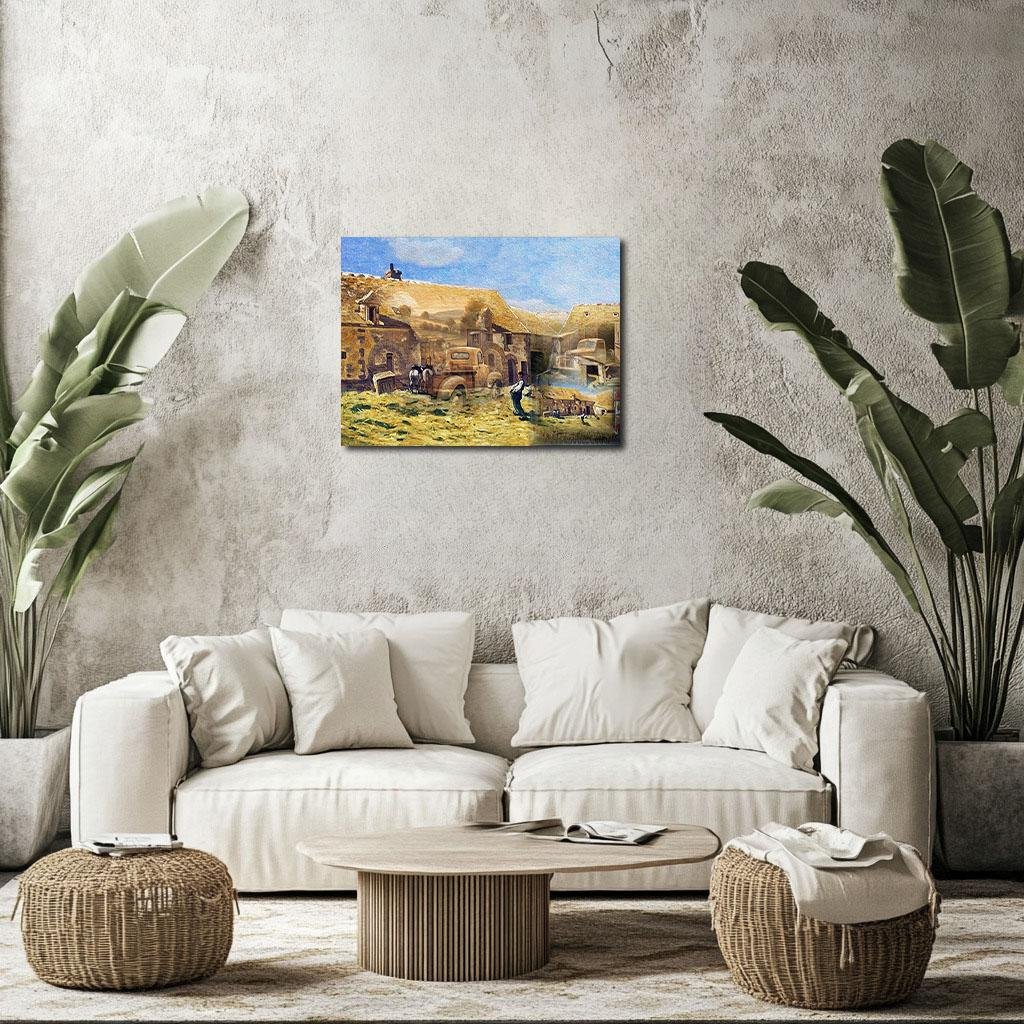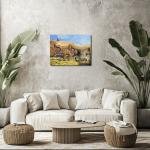Rust and Harvest: The Echo Fields of Chailly
Rust and Harvest: The Echo Fields of Chailly reimagines Monet’s 1865 Farmyard at Chailly as a conceptual meditation on time and transformation. Rusted trucks emerge from golden hay, blending with horses, barns, and layered memories of the land. Through soft color and ghosted forms, this collage evokes a landscape where history is not forgotten but folded into the present—an enduring conversation between past, labor, and quiet change.
Please see Below for Details…
Hotline Order:
Mon - Fri: 07AM - 06PM
404-872-4663
Claude Monet’s Farmyard at Chailly , painted in 1865, stands as a warm ode to rural life—a portrait of a quiet village caught in the natural rhythm of labor and land. The ochre-stained barns, thick slate roofs, and golden straw resting in the yard speak to a world bound to the earth. In this conceptual reinterpretation, titled Rust and Harvest: The Echo Fields of Chailly , the timeless stillness of Monet’s original scene expands into a layered meditation on change—of tools, of time, of memory—and how landscapes remember even as they are reshaped.
The bones of the farm remain, strong and weathered. The sturdy stone buildings of Chailly stand beneath a bright, clear sky, their facades dappled in warm sunlight. Yet, embedded within this rural tableau is a spectral layering of other eras—a quiet infiltration of mid-century machinery, forgotten vehicles, and the fading shadows of what once was progress. The scene is no longer a single moment—it is a dialogue between time periods, folding together the pastoral and the industrial, the human and the mechanical.
Central in the composition, half-sunk in golden hay, rests a rusted pickup truck. Its curves are soft with age, its paint worn to the memory of color. The truck does not clash with the farm buildings—it blends, like an old plow abandoned and weathered into the land. Horses stand beside it, not disturbed by its presence. They are echoes of a past still living, even as the world around them quietly shifts.
The man standing near the truck, dressed in period attire with a wide-brimmed hat and vest, becomes a figure of transition. He is both of Monet’s time and beyond it. His stance is casual but attentive, as if aware of the shifts in his world but accepting of them. He holds no tool, no map, no modern device—only posture and place. He is the human thread that binds together the natural and the mechanical, the remembered and the living.
Behind him, the walls of the farmhouse begin to dissolve. Not into sky, but into memory. Faintly layered across the stone are visions of open hills, tilled fields, and dusty roads. A truck moves down one of them, blending into the texture of the building like a story etched into stone. These layered landscapes are not literal—they are emotional recollections, the residue of seasons, of years, of labor and change layered into the grain of the place.
On the right side of the image, another truck rests half inside an open barn—its front facing us, its body darkened by time and shadow. It feels like a sentinel, a mechanical monument to all the changes that followed Monet’s gaze. Its headlights, though unlit, seem almost to watch, to witness. Around it, the barn remains unchanged, its structure sturdy, its wood grayed but not weakened. Here, the machines do not interrupt—they haunt.
Color plays a central role in guiding the emotional tone. The golden straw and earthy brown buildings are interrupted by the rusted orange of the trucks and the faint silvers of worn metal. These colors do not shout—they murmur, quietly pulling the viewer into reflection. The blue sky, bright and expansive, stretches over the entire scene with the clarity of late summer, untouched by the passage of time. It watches over a world that continues to shift, always under the same light.
As the artist, I approached this reinterpretation as an act of honoring. Monet saw in Chailly a kind of peace, a rhythm unbroken. This piece does not dispute that vision—it extends it. The presence of the trucks, the shadow of the road, the echo of other fields—these are not intrusions. They are inheritances. They speak to how the farmyard held not only animals and tools, but memory and time. They are the rust beneath the harvest, the echo that remains after wheels have stilled.
This collage becomes a meditation on continuity. The past is never truly past. It lingers in the texture of stone, in the pattern of fields, in the silence of barns. The man in the scene stands not just between buildings, but between centuries—one foot in straw, one in shadow. He watches the seasons continue, the wind carry dust across paint and wood. He does not speak. He listens.
Add your review
Your email address will not be published. Required fields are marked *
Please login to write review!
Looks like there are no reviews yet.








